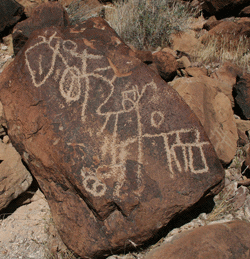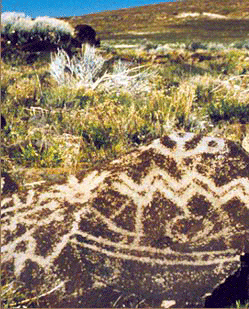Overview
Rock
art is markings, either painted (pictographs) or engraved
(petroglyphs) on the surface of rock or geoglyphs (large
figures produced by either removing the surface of the
ground or alignments of stone on the surface of the
ground). Rock art potentially gives a unique understanding
of the world view and culture of those who created it.
Rock art is found worldwide, and is one of the most visible remains
of past human activity. The most famous examples of
rock art are the painted caves of Europe or the paintings
of the Australian Aborigines. Although different from
these, Nevada's rock art is equally significant and
deserves to be documented, protected and brought to
the attention of a wider audience so we may better understand
the role art in prehistoric lifeways. Visit the Art of Ancient Nevada webpages for more information on rock art, Great Basin prehistory, and ethnography.
Nevada's increasing population threatens the existence of many of these archaeological sites. Natural elements and the public's lack of understanding are eroding the physical record of past cultural practices and the knowledge they contain. Supporting NRAF is an opportunity to help record Nevada's history through research and site protection.
Why Save Rock Art?
The
ancient peoples of North America left no written records
of their cultures. For us to gain an understanding of
what happened here in ancient times, we rely on clues
these early Americans left behind in the remains of
their villages, monuments, and artifacts. Rock
art is one of the most visible records of past human
social actions in the landscape and supplements archaeological knowledge of prehistoric lifeways derived from the remains of economic practices
Over
the past few decades, the knowledge and methods of modern
archaeology have advanced tremendously. Today, researchers
use technologies such as radiocarbon and tree-ring dating,
ground penetrating radar, pollen analysis, and trace-element
analysis to glean information from the archaeological
record. Few of these technologies existed 50 years ago.
For this reason, it is important that we keep a significant
record of rock art sites so that archaeologists
and scientists in the future, with even more advanced
knowledge and technologies, will have access to it.
Last updated 2/22/2014.



